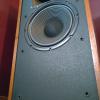Search the Community
Showing results for tags 'satellite'.
-
Hello Klipsch audio community, this is my first post here - actually I made an account specifically to ask about this topic, which has been mystifying me. I pick up multimedia speakers at my local thrift stores quite frequently, and Klipsch ProMedia speakers are a common sight (people seem to get rid of them because the pots on the control pods go bad). Usually I end up with a large number of ProMedia satellites with an odd mixture of subs and control pods, so I mix and match until I end up with complete systems, which isn't very difficult. I quickly noticed, however, that there seem to be a noticeable difference in tonality between some of the satellites - and the differences are often split between satellites from entire sets (for example, the 4 satellites I picked up from a ProMedia 4.1 set sounds noticeably brighter and louder than the satellites I found from an old ProMedia 2.1 set from the early 2000's). I know that companies often do iterative updates to their products' internal components, and I wanted a way to be able to identify the different satellite revision(s) so I can match them properly when I put together systems. After finding absolutely no cosmetic differences in the satellites' exterior, I decided to open them up... and what I discovered was a bit, well, surprising. In the photo attached below, you can see two satellites right next to each other. They look identical on the outside. Opening the first satellite, one can see a circuit board to handle the crossover. It appears to contain a capacitor, a resistor, and an inductor, pretty standard affairs for a crossover circuitry. Opening the second satellite, one finds that the entire circuit board to be missing. In its place is a single bipolar capacitor, manufactured by Bennic. My guess is that the first satellite is in fact the older version, because the circuit board is screwed onto two plastic mounts that, in the second satellite, are still present but unused. When I first started researching the topic, I came across an old discussion about the ProMedia 4.1, which was stated to have "improved crossover frequencies". Coincidentally, the first time I noticed the tonal differences in the satellites, it were ones from a ProMedia 4.1 system (containing the second version, with the single capacitor). I currently have 18 ProMedia satellite speakers on hand. I have opened up every single one, and found that 12 of them were of the second iteration, while only 6 were of the original configuration. So the "new" version has been around for a long while. I am not an electrical engineer, but a quick read on how crossover circuits work showed that inductors act as low pass filters (becoming more reactive as frequency increases), while capacitors act as high pass filters. The fact that the inductor and its companion resistor are absent in the "new" revision of the satellites likely means that the full-range driver is receiving the full spectrum of audio signal (minus whatever LFE that's sent to the subwoofer by the filter in the amp module), including everything that's meant for the tweeter. This may explain why these satellites sound somewhat brighter (I am assuming the full-range driver can reproduce at least some of the treble frequencies), as well as louder (less components in the signal path, less resistance). Now.. I know audio companies spend a lot of money on R&D, so I am not accusing Klipsch of cutting corners or anything like that. My main question is... which satellite version actually perform objectively better? I do not have any instruments to measure frequency responses, but may be someone can look into this? And a question for Klipsch: What is the reason behind this internal change? Do the new satellites still perform up to THX specifications?
-
Hello all! I bought these small Klipsch satellite speakers for my bedroom off of eBay and I have no idea what product it is. The seller did not know what speakers these were either, there's no text on the speakers saying the product info. They pretty great for the size and I was just wondering what product this is. I can't find anything like it under "discontinued products" on the Klipsch website. Thanks!
- 2 replies
-
- 1
-

-
- discontinued
- legacy
-
(and 3 more)
Tagged with:
-
Hey fellow Klipsch enthusiast I am looking for a pair of front ported bookshelf speakers to use as rears in my 7.2 HT. Sweet.








